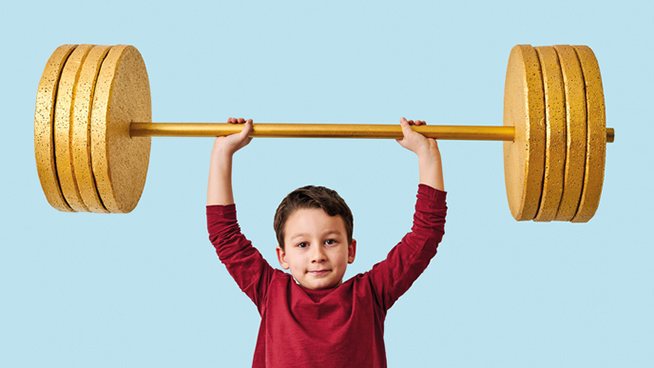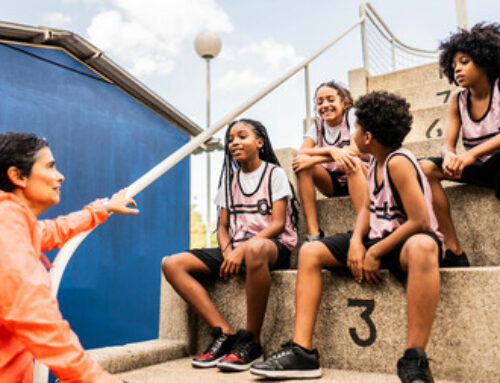Should Child Athletes Lift Weights?
For decades, there has been debate over the appropriate age for youth to begin resistance training. The old wives’ tale that it will stunt a child’s growth, claims that it reduces flexibility, and even worse, can cause serious injury. Fortunately, the majority of these claims have been debunked by research. It has been shown that resistance training is extremely safe for children, particularly compared to other sporting activities. Despite this research, a majority stance on when exactly to begin resistance training has never been firmly established. As a coach, I have been fortunate to work with athletes of all ages, including those in the ‘youth’ category (5-14 years old). When asked by a parent or fellow coach when they should start allowing their child/athlete to resistance train, my answer is always a resounding “as soon as possible.”
Start Lifting Now
First, rather than using the term resistance training, I prefer “performance training.” Unless you are a bodybuilder training purely for aesthetics, your training is likely aimed at enhancing performance, thus should be treated as such. I believe it is never too early for youth to seek improved performance. When beginning a program with a youth athlete (even as young as 4-5 years old), they should not start with anything too complex. For that manner, nobody’s performance training should start with anything too complex for the first time. Adding load to a movement must be earned. It is not a right.
As Gray Cook says, “never add strength to dysfunction.” One does not simply reach a magical age and suddenly begin back squatting. It is quite the opposite. As we age, we tend to drift further away from our natural ability to move efficiently and effectively unless we train properly. Further proof that it is critical to begin training from an early age.
Earn The Right To Add Load
Whether you are ten years old or 40, you must earn the right to add load by mastering the movement pattern in an unloaded fashion. Youth must master movement patterns such as squatting, hinging, stepping, crawling, and lunging before even sniffing a barbell. It can be difficult to get younger athletes to do these movements with focus and effort. However, a great way to do so is by incorporating them into games for better compliance and enjoyment. I have seen outstanding results from playing games like freeze tag, Simon says, and capture the flag with the movements previously discussed intertwined in a way that does not take the fun away.
While all this information is excellent for understanding the safety and efficacy behind training for youth athletes, it’s most important to understand why it helps improve athletic performance. Unfortunately, there is a misconception that youth athletes will get all the stimulus they need to improve strength, power, speed, endurance, etc., via participation in team sports alone however this is not the case. Many sports are unilaterally dominant or repetitive by nature thus they develop asymmetries and imbalances in the athlete. Couple this with the fact that our youth need additional activity today because of the sedentary American lifestyle we live, and it’s a no-brainer as to why training should commence as early as possible.

Cute child lifting gold barbell on blue pastel background. He is a determined and successful child.
Strength Training Program Guidelines
Here are some guidelines when considering strength-training programs:
- An coach-to-child ratio of no more than 1 to 10.
- The coach should have an approved strength-training certification and experience with kids and strength training.
- Warm-up with at least 5–10 minutes of aerobic activity and dynamic stretching.
- Cool down with less intense activity and static stretching.
- Begin with one set of 8–15 repetitions of 6–8 exercises that focus on the major muscle groups of the upper and lower body and core.
- Kids can start with bodyweight exercises (sit-ups and push-ups) and work on technique without using weights. When the proper technique is mastered, relatively light weight can be used with a high number of repetitions (8–15). Increase the weight, a number of sets, or types of exercises as strength improves.
- For best results, do strength exercises for at least 20–30 minutes 2 or 3 days per week. Take at least a day off between sessions.
One Caveat About Lifting Weights
A rather alarming misconception is that age must be placed on specific exercises or programs. Everybody matures, progresses, and learns differently. I’ve instructed athletes as young as 10 to perform barbell front squats because they were ready. Despite all of this, I emphasize learning and perfecting the movement pattern. Younger athletes are still developing neurologically and physiologically at a must faster rate than adults, therefore it is imperative to understand pushing strength/power qualities is not at the top of the list.
Although it’s still crucial, greasing the groove and becoming as neurologically efficient as possible ranks even higher in the hierarchy of youth athlete necessities. Treat training in the weight room much like a skill that you intend to improve on the practice field, and you will be doing your child/athlete a huge favor in their athletic development journey.
RECOMMENDED FOR YOU
MOST POPULAR
Should Child Athletes Lift Weights?
For decades, there has been debate over the appropriate age for youth to begin resistance training. The old wives’ tale that it will stunt a child’s growth, claims that it reduces flexibility, and even worse, can cause serious injury. Fortunately, the majority of these claims have been debunked by research. It has been shown that resistance training is extremely safe for children, particularly compared to other sporting activities. Despite this research, a majority stance on when exactly to begin resistance training has never been firmly established. As a coach, I have been fortunate to work with athletes of all ages, including those in the ‘youth’ category (5-14 years old). When asked by a parent or fellow coach when they should start allowing their child/athlete to resistance train, my answer is always a resounding “as soon as possible.”
Start Lifting Now
First, rather than using the term resistance training, I prefer “performance training.” Unless you are a bodybuilder training purely for aesthetics, your training is likely aimed at enhancing performance, thus should be treated as such. I believe it is never too early for youth to seek improved performance. When beginning a program with a youth athlete (even as young as 4-5 years old), they should not start with anything too complex. For that manner, nobody’s performance training should start with anything too complex for the first time. Adding load to a movement must be earned. It is not a right.
As Gray Cook says, “never add strength to dysfunction.” One does not simply reach a magical age and suddenly begin back squatting. It is quite the opposite. As we age, we tend to drift further away from our natural ability to move efficiently and effectively unless we train properly. Further proof that it is critical to begin training from an early age.
Earn The Right To Add Load
Whether you are ten years old or 40, you must earn the right to add load by mastering the movement pattern in an unloaded fashion. Youth must master movement patterns such as squatting, hinging, stepping, crawling, and lunging before even sniffing a barbell. It can be difficult to get younger athletes to do these movements with focus and effort. However, a great way to do so is by incorporating them into games for better compliance and enjoyment. I have seen outstanding results from playing games like freeze tag, Simon says, and capture the flag with the movements previously discussed intertwined in a way that does not take the fun away.
While all this information is excellent for understanding the safety and efficacy behind training for youth athletes, it’s most important to understand why it helps improve athletic performance. Unfortunately, there is a misconception that youth athletes will get all the stimulus they need to improve strength, power, speed, endurance, etc., via participation in team sports alone however this is not the case. Many sports are unilaterally dominant or repetitive by nature thus they develop asymmetries and imbalances in the athlete. Couple this with the fact that our youth need additional activity today because of the sedentary American lifestyle we live, and it’s a no-brainer as to why training should commence as early as possible.

Cute child lifting gold barbell on blue pastel background. He is a determined and successful child.
Strength Training Program Guidelines
Here are some guidelines when considering strength-training programs:
- An coach-to-child ratio of no more than 1 to 10.
- The coach should have an approved strength-training certification and experience with kids and strength training.
- Warm-up with at least 5–10 minutes of aerobic activity and dynamic stretching.
- Cool down with less intense activity and static stretching.
- Begin with one set of 8–15 repetitions of 6–8 exercises that focus on the major muscle groups of the upper and lower body and core.
- Kids can start with bodyweight exercises (sit-ups and push-ups) and work on technique without using weights. When the proper technique is mastered, relatively light weight can be used with a high number of repetitions (8–15). Increase the weight, a number of sets, or types of exercises as strength improves.
- For best results, do strength exercises for at least 20–30 minutes 2 or 3 days per week. Take at least a day off between sessions.
One Caveat About Lifting Weights
A rather alarming misconception is that age must be placed on specific exercises or programs. Everybody matures, progresses, and learns differently. I’ve instructed athletes as young as 10 to perform barbell front squats because they were ready. Despite all of this, I emphasize learning and perfecting the movement pattern. Younger athletes are still developing neurologically and physiologically at a must faster rate than adults, therefore it is imperative to understand pushing strength/power qualities is not at the top of the list.
Although it’s still crucial, greasing the groove and becoming as neurologically efficient as possible ranks even higher in the hierarchy of youth athlete necessities. Treat training in the weight room much like a skill that you intend to improve on the practice field, and you will be doing your child/athlete a huge favor in their athletic development journey.










